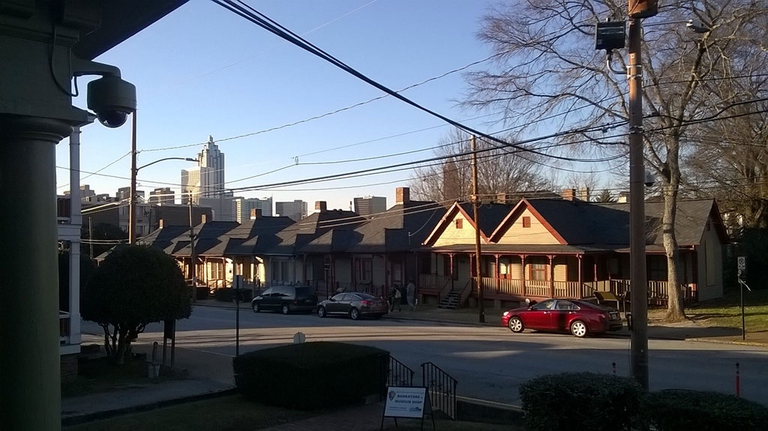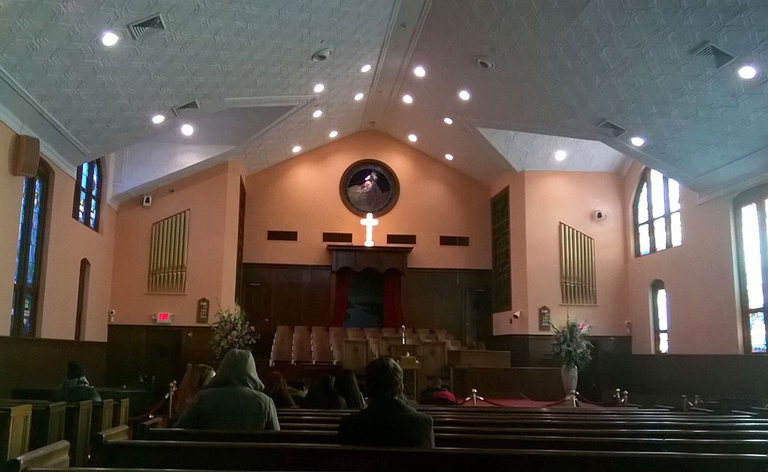
Homecast is a podcast series recorded in quarantine in which creatives from around the world share their lived experiences of these unique circumstances. Creator Giacomo De Poli tells us why this collective diary was needed now more than ever.
Martin Luther King’s childhood home and the surrounding area have become a National Historical Park. We went to Atlanta to visit it.
Atlanta, southeast of the United States. It’s a sunny winter day, but it’s freezing: according to locals, temperatures are even colder than usual. The icy wind doesn’t scare us, so we leave the city centre to reach the Sweet Auburn district, which now is home to a National Historical Park – the first in the state of Georgia.
“Can you imagine he walked here hundreds of times?,” a girl exclaims, her voice emotional, while dancing on the portico of a house that, in appearance, doesn’t seem so different from the others. We move closer to understand the reason of such enthusiasm and discover that here, on 15 January 1929, Martin Luther King Jr. was born. He lived in this house at 501 Auburn Avenue until he was 12. It’s easy to imagine him while playing basketball in the garden – it seems he was unbeatable – or running on the street to Fire Station No. 6, where he dreamed to work one day. A dream that couldn’t have become reality because, at the time, it was a job for white men only.
Read more: Martin Luther King Jr., biography of the man who changed the civil rights movement forever
Across the street you can find the houses where African Americans began to move after the 1906 race riot, when Empire Textile Co. employees who used to live there left the buildings. They’re called “shotgun houses” because the interior and exterior doorways are aligned, so a shot could supposedly be fired through them from front to back (or vice versa). Or maybe their name comes from the West African word “to-gun”, which means a place of assembly.
The atmosphere is difficult to describe: these buildings witnessed events that changed many people’s lives forever. Entering Ebenezer Baptist Church it’s almost like hearing the gospel choirs sung during Martin Luther King Jr.’s grandfather and father’s celebrations. He was a reverend, like them, and preached within these walls. His sermons have inspired those fighting for African American rights, then and today. The same goes for his speeches: the most famous one was pronounced on 28 August 1963 during the March on Washington for Jobs and Freedom whose title was “I have a dream”.
The site was upgraded to National Historical Park by the President of the United States, Donald Trump on 8 January: it includes the house, the church, and Martin Luther King Jr. and his wife Coretta Scott King’s tomb, as well as a visitor centre, the International World Peace Rose Garden, Freedom Hall (where exhibits and events are organised), the International Civil Rights Walk of Fame and two monuments (one dedicated to Mahatma Gandhi). Trump signed the bill aboard the Air Force One plane in the presence of King’s niece, slightly after he landed in Georgia to attend a football match against Alabama. The park now includes Prince Hall Masonic Temple, which served as the initial headquarters of the Southern Christian Leadership Conference (SCLC). “Through his life and work, Dr. Martin Luther King Jr. made America more just and free,” White House deputy press secretary Hogan Gidley told reporters. “This important historical park tells his story, and this bill will help ensure that the park continues to tell Dr. King’s story for generations to come”.
It was my great honor to sign H.R. 267, the “Martin Luther King, Jr. National Historical Park Act,” which redesignates the Martin Luther King, Junior, National Historic Site in the State of Georgia as the Martin Luther King, Jr. National Historical Park. https://t.co/Qe0b6HBFTY pic.twitter.com/QTgaqTawPT
— Donald J. Trump (@realDonaldTrump) 9 gennaio 2018
King founded the SCLC, giving a voice to African Americans in the fight against racial segregation, and he pursued nonviolent resistance through sit-ins, marches and by disobeying unfair laws. Together with John Lewis, the US representative for Georgia’s 5th congressional district and the man who introduced the bill Trump signed, he was a Freedom rider who didn’t fear imprisonment.
Martin Luther King Jr. won the Nobel Peace prize in 1964, the same year the Civil Rights Act was signed into US law, prohibiting racial segregation in the workplace, in schools and public places. He was killed on 4 April 1968 and now he’s buried next to his wife near Ebenezer Baptist Church. In some ways, however, he’ll live forever. You see this in the African American visitors who come to this place: many are teenagers and their eyes sparkle with admiration, surprise and gratitude for what this man has done for them. Their sense of wonder is uncontainable, like that of the girl we met at the beginning of our visit. A street poet even thanked us: “It’s nice you’ve been here.” The new law ensures the right conservation of a place which can’t, and must not be, forgotten.
Siamo anche su WhatsApp. Segui il canale ufficiale LifeGate per restare aggiornata, aggiornato sulle ultime notizie e sulle nostre attività.
![]()
Quest'opera è distribuita con Licenza Creative Commons Attribuzione - Non commerciale - Non opere derivate 4.0 Internazionale.
Homecast is a podcast series recorded in quarantine in which creatives from around the world share their lived experiences of these unique circumstances. Creator Giacomo De Poli tells us why this collective diary was needed now more than ever.
Time magazine’s 100 Women of the Year project sheds light on influential women’s stories, from Amelia Earhart to Greta Thunberg. A selection of some of the greats for International Women’s Day.
Leaving cliches behind, beauty and sexuality in old age are widely unexplored topics. Photographer Arianne Clément tells why she chose to shed light on this universe.
Un violador en tu camino – the rapist is you – is an anthem protesting the impunity of gender-based violence. It began in Chile and has become a global flash mob, bringing people to the streets and resonating all over the world.
The Oxford English Dictionary has chosen “climate emergency” as 2019’s Word of the Year because of its effectiveness in communicating a sense of urgency in the fight against global warming.
Filmmaker Dhondup Wangchen was imprisoned by the Chinese government for his documentary condemning the Tibetan condition. He tells us how he continues to fight for his people even after the traumas faced.
To mark the release of Anthropocene: The Human Epoch, we interviewed photographer and co-director Edward Burtynsky, who told us the story behind the documentary.
Snowflakes can be deceiving. Banksy transformed them from a marker of winter festivities into a symbol of the plague of air pollution in his mural Season’s greetings in Port Talbot, Wales.
Artist Jeff Hong imagined how Disney fairy tales’ characters would live in the real world: the result – or better the ending – is everything but happy.










